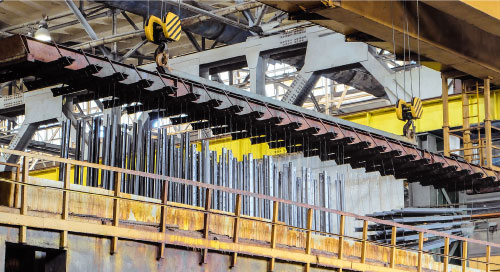Fill form to unlock content
Error - something went wrong!
Your content is just a step away. Please submit below.
Thank you!
Computer Vision Improves Galvanizing Plant Efficiency

What can computer vision and edge AI bring to a centuries-old industrial process? As galvanizing plant managers are discovering, these innovative technologies help deliver greater operational efficiency, cost savings, improved worker safety, and powerful sustainability benefits.
Galvanization, the process of coating steel and iron with zinc to prevent corrosion, first came into widespread use in the mid-nineteenth century—though the underlying chemistry was described as early as the 1740s. Now, advancements in AI are helping galvanizing businesses transform this old but still vital industrial process.
“Many galvanizing plants today still lack a unified tracking mechanism to monitor productivity,” says Harishankar Durairaj, Head of Technology and Product at SeeWise.AI, a computer vision specialist that offers digital transformation solutions to the galvanizing industry. “Using computer vision helps them to overcome that weakness—and also provides rich data insights that can be used to improve operational efficiency and worker safety.”
One Galvanizing Plant’s Real-World Results
SeeWise AI’s deployment with a large galvanizing business in India is case in point. The galvanizing plant in question is a large-scale operation—but despite their success, the business faced many challenges. It had no unified solution to monitor factory operations in real time. Production status updates had to be obtained by supervisors going out to the floor to check on progress manually. In a large facility, comprising 20 separate tanks for dipping, rinsing, and other stages in the galvanizing process, as well as materials storage and shipping areas, this proved extremely cumbersome. The lack of a centralized monitoring capability also made it hard to identify downtime issues and safety violations.
Working with the company’s management and operations teams, SeeWise.AI developed a comprehensive solution based on its True AI Powered Smart Factory platform to address these gaps. They installed a network of CCTV cameras to acquire a visual data stream from all areas of the plant. Using computer vision at the edge, the system analyzes this data to obtain real-time production data, detect machine downtime, and spot unsafe behavior by employees. The edge deployment helped reduce latency and enhance data security, and SeeWise engineers also took care to mask the biometric data of factory workers to protect their privacy.
The solution is designed to send real-time #automated alerts to supervisors when problems are discovered, such as an idle #machine that might point to a downtime issue. @SeeWiseAI via @insightdottech
The solution is designed to send real-time automated alerts to supervisors when problems are discovered, such as an idle machine that might point to a downtime issue. Alerts are handled through direct integration with operational equipment (such as buzzers or alarms on the factory floor) or via a centralized dashboard or mobile app.
The system also gives the galvanizing business greater insight into its operations. “We trained the AI model to monitor different steps in the production process, such as when a metal beam was immersed in a chemical tank, how long it was there, when it left the tank, and how long it sat waiting for someone to transport it to another area of the facility,” explains Durairaj. “This allowed management to identify bottlenecks and inefficiencies in the production process and improve on them.”
The implementation of the AI-powered solution, running on Intel-powered industrial computers has led to rapid improvements. For one thing, it can detect and correct downtime issues in real time and to ensure worker compliance with safety protocols. In addition, the plant managers use their newfound visibility into the production process to significantly improve operational efficiency. The plant’s overall equipment effectiveness (OEE) increased by 11% within the first three months. By month four, the business had achieved full ROI on the solution.
Making Computer Vision at the Edge More Cost-Effective
The software developed by SeeWise.AI is engineered to be agnostic to the input data source. Put another way, the system simply processes whatever video data it’s sent—without caring where that data stream came from or what brand of camera was used. That’s a significant advantage, because many galvanizing plants already have CCTV coverage for general security and monitoring purposes. Those existing video feeds can easily be repurposed to enable AI-powered productivity management and analytics, greatly reducing the initial capital expenditure costs of implementing a computer vision solution.
In addition, solutions like the Intel® OpenVINO™ toolkit help software developers more efficiently build their AI models. This offers further cost savings when first deploying a solution, because accurate AI model require less computing resources.
“OpenVINO has helped us tremendously with AI model efficiency and quantization,” says Duraiaj. “The hardware we used to need to support five cameras can now support as many as 10 cameras. That’s a direct result of the benefits offered by OpenVINO.”
Computer Vision in Galvanizing, Industry, and Beyond
The next decade will see a wave of digital transformation in the manufacturing sector—and computer vision technology will play a big role, both in galvanizing and other industries.
The upside is enormous, both in terms of operational efficiency and profitability. And just as importantly, computer vision also has the potential to deliver crucial sustainability benefits.
“If you’re manufacturing a galvanization product, but your process is inefficient, or you’re experiencing a high rate of defects, what happens? You contribute to increasing the global carbon footprint,” says Duraiaj. “Our mission is to make the planet more efficient, and computer vision is a powerful tool to make this happen.”
Computer vision, then, isn’t just helping to bring the technologies of the past into the present. It’s doing so in a way that will help create a more profitable and sustainable future.
Edited by Georganne Benesch, Editorial Director for insight.tech.